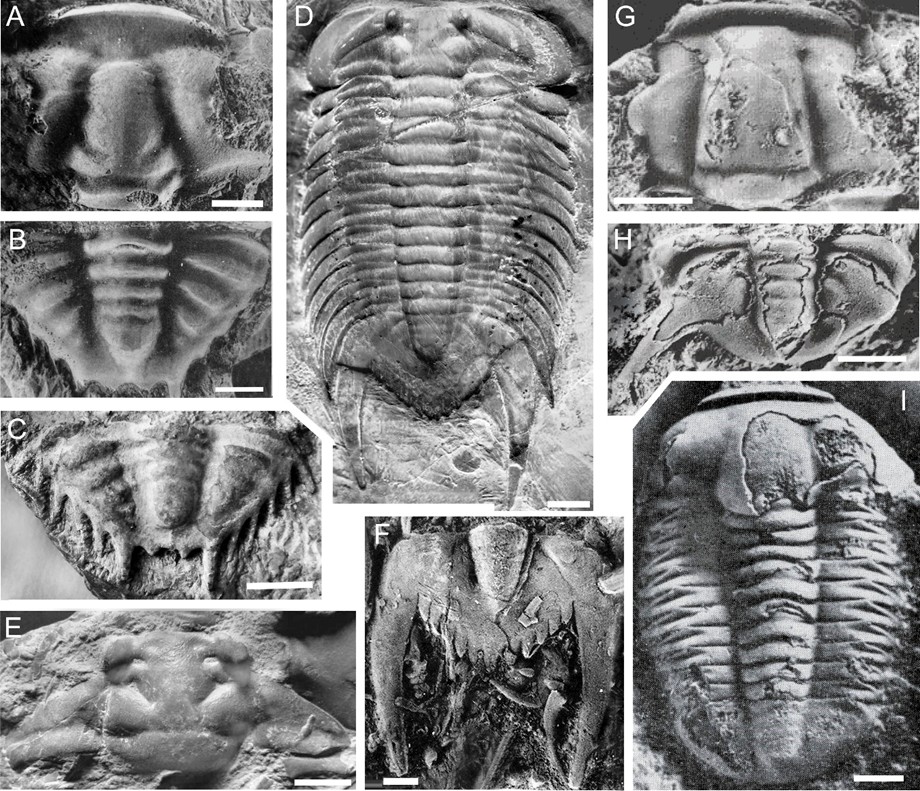Kushan Fm
Type Locality and Naming
The type section of Kushan Formation is the Tangwangzai section, on the southern slope of Tangwangzai, mountain fastness on the Baoquan Hill, about 2 km north of Kushan Township, Changqing County, Jinan City, Shandong Province (116°51’30”E, 36°30’03”N), and was remeasured by Zhang Zengqi et al. in 1992. In the type section, the formation is 62.42 m thick. The Kushan Formation was named by Blackwelder (1907). The name is derived from Kushan (spelled Gushan in Hanyu Pinyin) Town in Changqing District, Jinan City, northwestern Shandong Province. Blackwelder originally called the formation Kushan shale, referring it to the second lithologic unit of his Kiulung Group. Subsequently, it was informally called as Kushan formation by Sun (1924). Lu and Dong (1952) moved the upper boundary of the unit slightly down and named reduced Kushan formation as Kushan series that was renamed Kushan Formation by the Compiling Committee for Geology of China and Geological Institute of Chinese Academy of Sciences (1956). Zhang in Zhang and Liu (1996) returned the formation back to the original concept given by Blackwelder, which is followed herewith. Subsequently this unit was adopted as a Chinese standard Cambrian chronostratigraphic unit, the Kushanian Stage (Xiang et al., 1981; Zhang, 1985; Compiling Committee for Chinese Stratigraphic Lexicon et al., 1999), and had been used for a long time until a new four-fold chronostratigraphic subdivision was introduced (Peng, 2000a, b).
Synonym:
Lithology and Thickness
The Kushan Formation is dominated by yellowish green shale with interbeds of purplish red shale, grey thin-bedded lumpy-nodular limestone and edgewise conglomerate, intercalated with bluish grey, thin-bedded argillaceous limestone and sandy limestone, and occasionally with oolitic limestone and glauconite-bearing bioclastic limestone. In general, the Kushan Formation is formed by repetition of three lithologic kinds of rocks in rhythmic successions: edgewise conglomerate below, thin-bedded limestone, and shale above.
Relationships and Distribution
Lower contact
The Kushan Formation rests conformably on the underlying Changhia Fm. The lower boundary of the formation is marked by the appearance of thin-bedded edgewise conglomerate at the base of the formation. As noted the Zhang in Zhang and Liu (1996), there is actually a depositional break between the underlying Changhia and the Kushan formations, although the time break is very short and results no distinct hiatus of stratum.
Upper contact
It is overlain conformably by the Chaumitien Fm. The upper boundary is defined by the disappearance of shale of the formation.
Regional extent
Except for the Western Margin Area, the Kushan Formation is exposed in all other areas of the of North China Region, i.e., the Shanxi-Henan-Shaanxi, Xuzhou-Huaibei, Western Shandong, Northern Hebei-Western Liaoning and Liaoning-Jilin areas. It is distributed widely in the North China platform, including Shandong, Shanxi, Hebei, Jilin, Liaoning, northern Anhui and northern Jiangsu provinces. In Shandong Province the Kushan Formation varies considerably in thickness from 6 to 162 m. The Kushan Formation exposed in Hunjiang River basin in southwestern Jilin Province is 43 to 380 m thick, consisting of purple, purplish grey and greyish green shale and siltstone intercalated with sandy limestone; In the Taizihe River basin, Liaoyang area, central Liaoning Province, the formation is 85 m thick and changes in lithology from shale intercalated with limestone in the western part of the basin into limestone intercalated with shale in the eastern part. Extending further southward to Liaodong Peninsula, southern Liaoning Province, the formation bears even more thin-bedded limestone. In northern Anhui, the formation is 84 m thick and becomes totally carbonate sequence with limestone and dolomite and without shale.
GeoJSON
Fossils
Kushan Formation yields diverse damesellid trilobites and a few of agnostoid trilobites. The damesellids are characterized by having multiple spines in pygidium, and are unique taxa in eastern Asian and Australia. The damesellids from Kushan Formation include: Bergeronites, Blackwelderia, Dameselloides, Damesops, Hebeia, Guancenshania, Neodrepanura, Parablackwelderia, Paradamesella, Pingquania, Protaitzehoia, Pseudoblackwelderia, Shantungia, Stephanocare, Taihangshaniashania, Taitzehoia, and Teinistion. Other key polymerids from Kushan Formation include: Chuangia, Changshania, Diceratocephalus, Liostracina, Monkaspis, Paracoosia and Prochuangia etc., and agnostoids include: Ammagnopstus, Homagnostus, Quadrahomagnostus, and Pseudagnostus etc.
[Figure: Some index fossils of the Kushan Formation. A−C, Blackwelderia paronai (Airaghi, 1902), cranidium, pygidium and pygidium, from the Blackwelderia paronai Zone, Dingxiang, eastern Shanxi Province (A, B) and Dawenkou, western Shandong Province (C); D−F, Neodrepanura premesnili (Bergeron, 1899), exoskeleton, cranidium, and pygidium, from the Neodrepanura premesnili Zone, Laiwu, western Shandong Province; G, H, Prochuangia depressa Qian, 1994, cranidium and pygidium, from the Prochuangia-Paracoosia Zone, Benxi, eastern Liaoning Province; I, Chuangia subquadrangulata Sun, 1935, exoskeleton, from the Chuangia Zone, Jiawang, northern Jiangsu Province. Prochuangia depressa and Chuangia subquadrangulata range up also into the Chaumitien Formation. Scale bar = 5 mm for A−C; 4 mm for D−I.]
Age
Depositional setting
Additional Information
